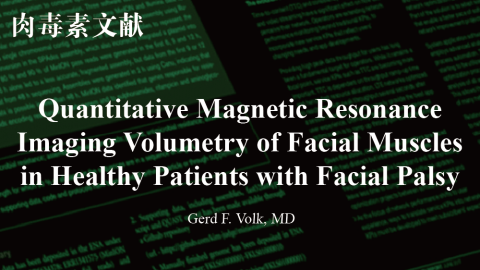
- 3484人
- 分享收藏
Quantitative Magnetic Resonance Imaging Volumetry of Facial Muscles in Healthy Patients with Facial
Gerd F. Volk, MD
简介
【 文献重点摘要 】
Background
Magnetic resonance imaging (MRI) has not yet been established systematically to detect structural muscular changes after facial nerve lesion. The purpose of this pilot study was to investigate quantitative assessment of MRI muscle volume data for facial muscles.
Methods
Ten healthy subjects and 5 patients with facial palsy were recruited. Using manual or semiautomatic segmentation of 3T MRI, volume measurements were performed for the frontal, procerus, risorius, corrugator supercilii, orbicularis oculi, nasalis, zygomaticus major, zygomaticus minor, levator labii superioris, orbicularis oris, depressor anguli oris, depressor labii inferioris, and mentalis, as well as for the masseter and temporalis as masticatory muscles for control.
Results
All muscles except the frontal (identification in 4/10 volunteers), procerus (4/10), risorius (6/10), and zygomaticus minor (8/10) were identified in all volunteers. Sex or age effects were not seen (all P > 0.05). There was no facial asymmetry with exception of the zygomaticus major (larger on the left side; P = 0.012). The exploratory examination of 5 patients revealed considerably smaller muscle volumes on the palsy side 2 months after facial injury. One patient with chronic palsy showed substantial muscle volume decrease, which also occurred in another patient with incomplete chronic palsy restricted to the involved facial area. Facial nerve reconstruction led to mixed results of decreased but also increased muscle volumes on the palsy side compared with the healthy side.
Conclusions
First systematic quantitative MRI volume measures of 5 different clinical presentations of facial paralysis are provided.
背景
磁共振成像(MRI)尚未建立系统的方法来检测面神经损伤后的结构性肌肉改变。这项初步研究的目的是调查面部肌肉MRI肌肉体积数据的定量评估。
方法
选择10例健康人和5例面瘫患者。采用3T MRI手动或半自动分割方法,测量额肌、前轮匝肌、上睑皱肌、眼轮匝肌、鼻肌、颧大肌、颧小肌、上唇提肌、口轮匝肌、口降角肌、下唇降肌和脑肌的容积,并以咀嚼肌和颞肌为对照。
结果
除额肌(4/10例)、前额肌(4/10例)、升中肌(6/10例)、颧小肌(8/10例)外,其余肌肉均被识别。性别、年龄差异均无统计学意义(均P>0.05)。面部除颧大肌(左侧较大,P=0.012)外,无面部不对称。对5名患者的探查显示,面部损伤后2个月瘫痪侧的肌肉体积明显变小。1例慢性麻痹患者出现明显的肌肉体积减少,另1例局限于受累面部的不完全性慢性麻痹患者也出现此现象。面神经重建术与健侧相比,面神经重建术的结果好坏参半,患侧肌肉体积减少,但肌肉体积也增加。
结论
首先提供了5种不同临床表现的面神经麻痹的系统定量MRI容积测量结果。



